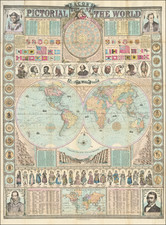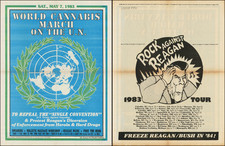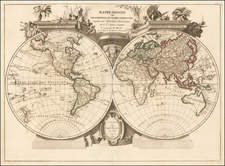Scarce 8-sheet map of the World, published in Zurich in English and French, showing the various parts of the world colored based upon Geological classifications.
At the time of publication of the map, Marcou offered the following comments 'read before the Boston Society of Natural History, March 19, 1873, which were printed in the American Naturalist,
In 1859 I finished the manuscript of a geological map of the earth, which appeared two years after at Winterthur, Switzerland, in eight sheets, on a scale of 1: 23,000,000. The map, prepared by the learned geographer, my friend M. J. M. Ziegler, on Mercator's plan, although defective as regards certain details of execution resulting from my departure from Zurich to Boston, has, however, been received with favor by geologists as filling a desideratum in science. Some reductions and translations, with my consent, have been made in German, French and English.
I have now just finished the manuscript of a second edition, intended to be placed in the International Exposition of Vienna, in May, 1873.
Not only have I carefully reviewed all the materials used in preparing the first edition; but also profited by numerous and important additions published during the past fourteen years, and have had in my hands a certain number of inedited geological maps and observations, which have been very liberally furnished by geologists who have explored and inhabited different countries remote and diflicult of access. Let us pass in review very succinctly the more important of these new materials.
In the Arctic regions several expeditions have enabled us to color geologically a part of the islands of Spitzbergen, of Greenland, and to modify the geological age of the coal deposits of the is' lands of Disco, Prince Patrick and Bank's Land. M. Nordenskiold has published at Stockholm a "Sketch of the Geology of Spitzbergen," where he recognizes the crystalline rocks, the Palaeozoic, Carboniferous, Triassic, Jurassic and Tertiary. But the most unexpected discoveries, in latitudes so high, are those of terrestrial floras, dating at the miocene tertiary epoch, when, according to Professor 0. Heer, all the northern polar region was covered with a vegetation analogous to that which to-day exists in the southern part of the temperate region of the northern hemisphere.
The geological survey of the kingdom of Norway directed by Prof. Kjerulf, besides some important modifications in the geographical distribution of rocks of the southern part of this country, has discovered a coal field'of great interest from its geographical position, in one of the isles of the group of Lofl'oden, the island of Andi), as well as its geological age, which dates from the Jurassic epoch, as the coal bed of the coast of Yorkshire.
The great geological map of the entire Austro-Hungarian monarchy, published by M. F. R. von Hauer, has enabled us to rectify and to give more precision to the geology of the Eastern Alps, of Carpathia, of Dalmatia and Hungary. General IIelmersen published at St. Petersburg, in 1863, a new edition of the geological map of Russia, based on that of Messrs. Murchison, Verneuil and Keyserling. But the most important modifications have been made in Russian geology by the researches of Messrs. Ludwig, Barbot de Marny, V. dc Mtiller and Wagner, who have demonstrated the existence of an enormous Triassic formation, extending over a considerable extent of country, and which had been confounded and comprised by Sir Roderick Murchison and his collaborators with the Zechstein and Rothliegende, under the improper name of the Permian system. This question of the Russian "Dyas and Trias," raised by me in 1859, has received a definite and entire solution in the sense of my views, in the important work "Dyas" by Dr. H. B. Geinitz, Leipzig, 1862, and in "The Geological Map of the Western Slope of the Ural " by Valérien de Moller, St. Petersburg, 1869.
The geology of Egypt and Palestine has been especially modified by the researches of my friend Dr. Oscar Fraas, who has kindly sent me besides his journey entitled " To the Orient," a manuscript geological map of those regions. The English military expedition to Abyssinia has been of the greatest advantage to geology, and Mr. W. T. Blanford, of the Geological Survey of India, who accompanied the expedition, has published a geological map of the route traversed by the English army. For a long time geologists have disagreed as to the age of a great sandstone formation designated generally under the name "Nubian Sandstone," and in the first edition of the "Geological Map of the Work ," I have referred these sandstones to the New Red Sandstone (Dyas and Trias) by basing my conclusions on the lithology and on a piece of fossil wood found in Egypt, and described by Professor Unger. M. Louis Lartet, jr., after a journey in these regions, believed that he had discovered a complete and exact solution of the age of these sandstones; and in his work entitled " Essay on the Geology of Palestine, Egypt and Arabia," Paris, 1869, as also in a note.insorted in the " Bulletin of the Geological Society of France," vol. xxv, p. 490, under the title of "On a Special Formation of Red Sandstones in Africa and Asia" he refers them not only to the Cretaceous formation, but even the horizon of the Gault and of the Glauconian chalk ; and on a geological map he shows this formation extending from Lebanon, by Sinai, to the Cataracts of Assouan as far as Karthoum. Mr. Blanford has indicated these N ubiau Sandstones, which he has named Adrigat Sandstone, under some fossiliferous limestones containing a Jurassic fauna and which he has named "Antalo Limestone." and he is led to regard the Nubian Sandstones as of the age of the New Red Sandstone (Dyas and Trias). As 'regards Sinai, two English observers, Messrs. 'Vilson and Holland have shown in these Nubian Sandstones the presence of some carboniferous fossils, or at least of fossils of the age of the Dyas. Thus the determination of the epoch of the New Red Sandstone for the Nubian Sandstone appears to be confirmed.
The geology of India has continued to be the object of very important researches on the part of Thos. Oldham and his assistants in the geological survey of this vast empire. My friend Mr. Oldham has kindly sent me a manuscriptmap which modifies greatly the results which I had accepted for the first edition of my map.
In China, we have had some data quite exact on several points, thanks to the researches of Messrs. Kingsmill, the Abbe David, Pumpelly and Bickmore. Professor E. Beyrich has published a work on the Island of Timor, and M. Jules Garnier has given a geological map of New Caledonia.
New Zealand, thanks to the researches of Messrs. Ferdinand VonHoehstetter, Julius Haast and James Hector, is today completely known, and I owe to the kindness of the two last named savants, a manuscript geological map of these isles, which has just appeared at Wellington under the title of " Sketch Map of the Geology of New Zealand."
No country has made so much progress in geology during the last twelve years as Australia. The discovery and search for gold have certainly contributed to it, and the different colonies have devoted considerable sums towards sustaining geological surveys and mining statistics. The colony of Victoria especially has shown the example in the construction of a good geological map by Messrs. Selwyn, Brough Smyth, Ulrich, Henry Y. L. Brown, etc. From Tasmania I have received a manuscript map of all of Van Diemen's Land by Mr. Charles Gould, who for several years has directed the Geological Survey. In New South 'Vales the Rev. W. B. Clarke has given in numerous memoirs some excellent generalities on this part of the Australian Continent; and Mr. R.
Daintree has just published a "Sketch Map of the Geology of Queensland" (Quart. Journ. of the Geol. Soc. of London, vol. xxviii, p. 271, 1872.) Finally, during these last two years Mr. Henry Y. L. Brown has made a geological reconnoissance of Western Australia.
Mr. Alfred Grandidier has given in grand outlines the general characters of the island of Madagascar, which appears to have almost nothing in common with South Africa, while it possesses great affinities with the geology of Western Australia, and even of New Zealand. Southern Africa has for several years, and especially since the discovery of the diamond mines, been the object of geological researches, which allow us to trace with considerable exactitude the principal lines of its geognostical constitution. The geological map of the colony of Natal has been published by Mr. C. L. Griesbach, and the great formation of the Karoo Sandstone, analogous to and probably identical with the Nubian Sandstone, has been studied with care by Messrs. G. W. Stow, G. Grey, Atherstone and Evans. Messrs. Jones and Huxley have coordinated and expressed general views on researches made on the same localities; and I "owe to the friendship of Professor T. Rupert Jones a manuscript map reviewing all that has been done in this southern portion of the African continent.
In the New World Messrs. Masters and F. de Pourtales have discovered a group of extinct volcanoes between the River Gallegos, Cape Virgins and the eastern entrance of Magellan Straits, in Patagonia. Professor Burmeister, Director of the Museo Publico of Buenos Ayres, has sent me a manuscript geological map of the Argentine Republic, and Mr. David Forbes has published a new geological map of a part of Bolivia and Peru, which slightly modifies the most complete and detailed one of' the late Alcide d' Orbigny. '
In Brazil some great modifications and corrections have been introduced by the researches of Messrs. Hartt, Coutinho, Chandless and Orton, especially in the basin of the Amazons, and on the shore of the Atlantic Ocean. The Devonian and Carboniferous formations have been traced to Mont Ereré and to the first Cataract of the River Tapajos; the Cretaceous formation is found in upper Purus, and the Tertiary formation near Pebas on the River Marafion.
Mr. Charles B. Brown has sent me a manuscript geological map of English Guiana, the geological survey of which he has directed for several years. The same savcmt published several years ago, in collaboration with Mr. J. G. Sawkins, a detailed geological map of Jamaica.
Venezuela and the United States of Columbia, or New Granada, have been explored by Messrs. Rogias, Uricoechea and Dr. Maaek, all of whom have very kindly communicated to me their interesting and diflicult researches. The republics of San Salvador and of Guatemala have been explored by the late August Dollf us and M. E. de Montserrat, who have given a geological map of them. Finally, Baron F. von Gerolt. for a long time Prussian minister to Mexico, has published in New York a geological map of a part of the vast plateau, principally of volcanic origin, which extends between Puebla, Guerrero, Guanujuato and San Luis Potosi in Mexico.
The United States and the British Provinces of North America have continued to be the object of numerous researches and geological publications. I may signalize especially (1') in Hudson's Bay Territory the explorations of Messrs. J. Hector, Kennicott, Hind, Bell and Richardson; (2) the numerous journeys and studies of Dr. Hayden on the Upper Missouri; (3) the remarkable discoveries of Dr. Newberry in Arizona and New Mexico, of Messrs. C. King, Rémond de Corbineau, H. Engelmann, S. F. Emmons, Marsh, Cope and Gilbert in California, Nevada, Utah, Wyoming, Colorado and Sonora.
I have preserved the same classification of rocks and the same colors, except for the pliocene formation, which I have taken out of the tertiary formation to place it with the quaternary and modern formations, with which it has more aflinities. The classification of stratified rocks is merely provisional, and it is really accurate but only for the northern temperate zone, and even in that zone it is limited to the basins of the Atlantic Ocean and of the Mediterranean Sea. However, as we go from these limits, and as we arrive in India or on the Missouri and in California, then we encounter difiiculties, that have been noticed and treated of quite plainly by most'observers, which are obstacles which can not be passed over in silence nor yet avoided. For a stronger reason when we leave the north temperate zone, we find some anomalies and difiiculties which, far from tending to be cleared up with time. on the contrary prove more and more the insufficiency of our classifications and the slight value of so-called palaeontological laws. Let us cite some summary examples:
In the Punjab, on the southern side of the Salt Range, near Jabi, Dr. William Waagen has just found some "Goniatites, Ceratites and Ammonites all together in a limestone bed of about one foot and a half in thickness, associated with unmistakable Producti, Athyris, etc." (See: On the Occurrence of Ammonites associated with Ceratites and Goniatites in the Carboniferous deposits of the Salt Range, "Mem. Geol. Surv. of India," vol. ix, art. 4. That is to say that there occur in the same beds, fossil forms which in Central Europe indicate Carboniferous, Triassic and J urassic formations.
In the Valley of the Missouri the forms of fossil Brachiopods, which in Europe characterize the Mountain Limestone, such as Producti, Athyris, Spirifer, etc., are found in some beds which contain at the same time some other fossils, of which the forms Allorisma, Solemia, Schizodus and Pleurophorus, indicate in Europe the Dyas (formerly improperly called Permian). Thus several geologists have ignored the existence of the Dyas in Nebraska, in Iowa, and in Illinois, and have sought to substitute for it a formation of passage that they name Dyaso or PermioCarboniferous.
In California the forms of Tertiary and Cretaceous fossils are mixed together in such a way that some refer some groups of rocks to the Cretaceous formation, while others regard them as of the Tertiary epoch.
In Australia, some beds containing Carboniferous Brachiopods are found placed beneath and even alternately with coal containing a flora regarded in Yorkshire (England) as Jurassic. Finally in New Zealand, the formations called Secondary seem to be entirely obliterated ; and it has been necessary to unite some rocks in the same groups under the bizarre name of upper Palaeozoic or lower Secondary, ignorant to which of the two to refer them; and of the upper Secondary or lower Tertiary.
These examples show that our classifications and our laws are still imperfect, and also the progress there remains to be made in order to thoroughly know the history of the earth. The attempts at classifications of eruptive and stratified rocks; those, not less numerous, of the relative ages of interruptions in the deposits of Stratified rocks;- the study of the breaks and dislocations which have taken place on the surface of our planet, and of the relations which may exist between the one and the other, are all premature attempts, and of doubtful value. Having a knowledge, not even very profound, of some localities, theorizers have launched into the midst of generalities the value of which is very debatable even in the interests of geology. But as it is a quality of human nature of always wishing to theorize and to go from the particular to the general, and as we are always foul of simple explanations and a priori views, we easily fall into an admiration for all those who seem to unveil and render themselves masters of the secrets of nature, and who expose them in certain brilliant mathematic laws, enhanced by the attraction of difficulties overcome, and of secrets unveiled. Vain efforts! They are only deceiving mirages. Ten, twenty, thirty years of observation dissipate them. and demonstrate their insufficiency and falsity. It is observation alone. Observe! Always observe! Do not leave a single corner of the globe without the minute observations of travelling and of resident geologists; and then we can generalize, and the mysteries of our planet will be unveiled and systematized in a synthesis, solid, logical with facts, well balanced and truly philosophical.
Jules Marcou was perhaps the most famous geologist of his time. He worked in early years with Jules Thurmann (1804-1855) on the geology of the Jura Mountains. In 1847 he went to North America as travelling geologist for the Jardin des Plantes, and in the following year in Boston he joined Agassiz, whom he had met in Switzerland, and accompanied him to the Lake Superior region.
Marcou spent two years in studying the geology of various parts of the United States and Canada, and returned to Europe for a short time in 1850. In 1853 he published a Geological Map of the United States, and the British Provinces of North America. In 1855 he became professor of geology and palaeontology at the polytechnic school of Zürich, but relinquished this office in 1859, and in 1861 again returned to the United States, when be assisted Louis Agassiz in founding the Museum of Comparative Zoology.
The present map is quite rare. It was published in Zurich by J.Wurster & Co., with distribution in Paris by Edward Stanford & Co, Paris by F. Savy and in Milan, Naples and Pisa by Ulrico Hoepli.










![Western Hemisphere | Eastern Hemisphere [2 sheets]](https://storage.googleapis.com/raremaps/img/small/85676.jpg)

![Western Hemisphere [and] Eastern Hemisphere](https://storage.googleapis.com/raremaps/img/small/85988.jpg)

![[Early Photographic Facsimile of the Catalan-Estense World Map]](https://storage.googleapis.com/raremaps/img/small/66756.jpg)